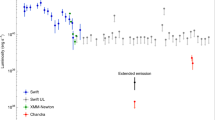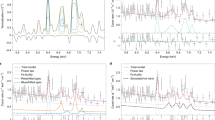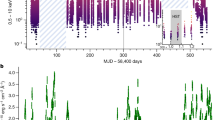Abstract
Ultraluminous X-ray sources are extragalactic, off-nucleus, point sources in galaxies, and have X-ray luminosities in excess of 3 × 1039 ergs per second. They are thought to be powered by accretion onto a compact object. Possible explanations include accretion onto neutron stars with strong magnetic fields1, onto stellar-mass black holes (of up to 20 solar masses) at or in excess of the classical Eddington limit2,3,4, or onto intermediate-mass black holes (103–105 solar masses)5. The lack of sufficient energy resolution in previous analyses has prevented an unambiguous identification of any emission or absorption lines in the X-ray band, thereby precluding a detailed analysis of the accretion flow6,7,8. Here we report the presence of X-ray emission lines arising from highly ionized iron, oxygen and neon with a cumulative significance in excess of five standard deviations, together with blueshifted (about 0.2 times light velocity) absorption lines of similar significance, in the high-resolution X-ray spectra of the ultraluminous X-ray sources NGC 1313 X-1 and NGC 5408 X-1. The blueshifted absorption lines must occur in a fast-outflowing gas, whereas the emission lines originate in slow-moving gas around the source. We conclude that the compact object in each source is surrounded by powerful winds with an outflow velocity of about 0.2 times that of light, as predicted by models of accreting supermassive black holes and hyper-accreting stellar-mass black holes9,10.
This is a preview of subscription content, access via your institution
Access options
Subscribe to this journal
Receive 51 print issues and online access
$199.00 per year
only $3.90 per issue
Buy this article
- Purchase on Springer Link
- Instant access to full article PDF
Prices may be subject to local taxes which are calculated during checkout




Similar content being viewed by others
References
Bachetti, M. et al. An ultraluminous X-ray source powered by an accreting neutron star. Nature 514, 202–204 (2014)
Shakura, N. I. & Sunyaev, R. A. Black holes in binary systems: observational appearance. Astron. Astrophys. 24, 337–355 (1973)
Poutanen, J. et al. Supercritically accreting stellar mass black holes as ultraluminous X-ray sources. Mon. Not. R. Astron. Soc. 377, 1187–1194 (2007)
King, A. R. et al. Ultraluminous X-ray sources in external galaxies. Astrophys. J. 552, L109–L112 (2001)
Pasham, D. R., Strohmayer, T. E. & Mushotzky, R. F. A 400 solar mass black hole in the ultraluminous X-ray source M82 X-1 accreting close to its Eddington limit. Nature 513, 74–76 (2014)
Stobbart, A.-M., Roberts, T. P. & Wilms, J. XMM-Newton observations of the brightest ultraluminous X-ray sources. Mon. Not. R. Astron. Soc. 368, 397–413 (2006)
Bachetti, M. et al. The ultraluminous X-ray sources NGC 1313 X-1 and X-2: a broadband study with NuSTAR and XMM-Newton. Astrophys. J. 778, 163–173 (2013)
Middleton, M. J., Walton, D. J., Roberts, T. P. & Heil, L. Broad absorption features in wind-dominated ultraluminous X-ray sources? Mon. Not. R. Astron. Soc. 438, L51–L55 (2014)
King, A. & Pounds, K. Powerful outflows and feedback from active galactic nuclei. Annu. Rev. Astron. Astrophys. 53, 115–154 (2015)
King, A. & Muldrew, S. I. Black hole winds II: hyper-Eddington winds and feedback. Mon. Not. R. Astron. Soc. 455, 1211–1217 (2016)
Gladstone, J. C., Roberts, T. P. & Done, C. The ultraluminous state. Mon. Not. R. Astron. Soc. 397, 1836–1851 (2009)
Middleton, M. J. et al. Diagnosing the accretion flow in ULXs using soft X-ray atomic features. Mon. Not. R. Astron. Soc. 454, 3134–3142 (2015)
Kaspi, S. et al. The ionized gas and nuclear environment in NGC 3783. I. Time-averaged 900 kilosecond Chandra grating spectroscopy. Astrophys. J. 574, 643–662 (2002)
Ponti, G. et al. Ubiquitous equatorial accretion disc winds in black hole soft states. Mon. Not. R. Astron. Soc. 422, L11–L15 (2012)
Miller, J. M. et al. The accretion disk wind in the black hole GRO J1655–40. Astrophys. J. 680, 1359–1377 (2008)
Marshall, H. L., Canizares, C. R. & Schulz, N. S. The high-resolution X-ray spectrum of SS 433 using the Chandra HETGS. Astrophys. J. 564, 941–952 (2002)
Schulz, N. S. et al. Double-peaked X-ray lines from the oxygen/neon-rich accretion disk in 4U 1626–67. Astrophys. J. 563, 941–949 (2001)
Cooke, B. A., Fabian, A. C. & Pringle, J. E. Upper limits to X-ray emission from colliding stellar winds. Nature 273, 645–646 (1978)
Oskinova, L. M. Evolution of X-ray emission from young massive star clusters. Mon. Not. R. Astron. Soc. 361, 679–694 (2005)
Strüder, L. et al. The European Photon Imaging Camera on XMM-Newton: the pn-CCD camera. Astron. Astrophys. 365, L18–L26 (2001)
Turner, M. J. L. et al. The European Photon Imaging Camera on XMM-Newton: the MOS cameras. Astron. Astrophys. 365, L27–L35 (2001)
den Herder, J. W. et al. The Reflection Grating Spectrometer on board XMM-Newton. Astron. Astrophys. 365, L7–L17 (2001)
Roberts, T. P. et al. Chandra monitoring observations of the ultraluminous X-ray source NGC 5204 X-1. Mon. Not. R. Astron. Soc. 371, 1877–1890 (2006)
Kalberla, P. M. W. et al. The Leiden/Argentine/Bonn (LAB) Survey of Galactic HI. Final data release of the combined LDS and IAR surveys with improved stray-radiation corrections. Astron. Astrophys. 440, 775–782 (2005)
Lodders, K. S. & Palme, H. Solar system elemental abundances in 2009. Meteorit. Planet. Sci. Suppl. 72, 5154 (2009)
Nomoto, K. et al. Nucleosynthesis yields of core-collapse supernovae and hypernovae, and galactic chemical evolution. Nucl. Phys. 777, 424–458 (2006)
Swartz, D. A. et al. The ultraluminous X-ray source population from the Chandra archive of galaxies. Astrophys. J. Suppl. Ser. 154, 519–539 (2004)
Pakull, M. W. & Mirioni, L. Optical counterparts of ultraluminous X-ray sources. Preprint at http://arxiv.org/abs/astro-ph/0202488 (2002)
Goad, M. R., Roberts, T. P., Reeves, J. N. & Uttley, P. A deep XMM-Newton observation of the ultraluminous X-ray source Holmberg II X-1: the case against a 1000-M⊙ black hole. Mon. Not. R. Astron. Soc. 365, 191–198 (2006)
Pinto, C., Kaastra, J. S., Costantini, E. & de Vries, C. Interstellar medium composition through X-ray spectroscopy of low-mass X-ray binaries. Astron. Astrophys. 551, A25–A35 (2013)
Kaastra, J. S. et al. Multiwavelength campaign on Mrk 509. II. Analysis of high-quality Reflection Grating Spectrometer spectra. Astron. Astrophys. 534, A37–A52 (2011)
King, A. L. et al. Regulation of black hole winds and jets across the mass scale. Astrophys. J. 762, 103–120 (2013)
Acknowledgements
We thank A. Lohfink for help with the use of photoionization emission codes. A.C.F. acknowledges support from the European Research Council through Advanced Grant on Feedback 340492. M.J.M. appreciates support from an STFC advanced fellowship. This work is based on observations with XMM-Newton, an ESA science mission with instruments and contributions directly funded by ESA Member States and NASA. This research has also made use of data obtained from NASA’s Chandra satellite. All codes used are publicly available.
Author information
Authors and Affiliations
Contributions
C.P. wrote the manuscript with comments from all authors, and analysed the XMM-Newton data. Both M.J.M. and A.C.F. made substantial contributions to the overall science case and manuscript.
Corresponding author
Ethics declarations
Competing interests
The authors declare no competing financial interests.
Extended data figures and tables
Extended Data Figure 1 EPIC MOS+PN stacked image of NGC 1313.
The circular source extraction regions (large white circles) have a diameter of 1 arcmin. The small region to the south of X-1 (small white circle) is a star-forming region near the galactic centre, orders of magnitude fainter across the 0.3–10 keV bandpass than X-1. The strip enclosed within dashed yellow lines is the RGS extraction region. Counts per pixel are colour coded (key at bottom).
Extended Data Figure 2 ACIS image of NGC 1313 X-1 and the nearby star-forming region, SFR.
The ultraluminous X-ray source is the brightest object. The small circles have 6 arcsec radii, that is, 0.1 arcmin; the larger circle has 0.5 arcmin radius. Counts per pixel are colour coded (key at bottom).
Extended Data Figure 3 EPIC MOS+PN stacked images of NGC 5408 and NGC 6946.
a, NGC 5408; b, NGC 6946. The ultraluminous X-ray sources are the brightest objects in both images. Additional, nearby X-ray bright sources—mostly high-mass X-ray binaries and background active galactic nuclei—can be seen. The white circular source extraction regions have a diameter of 1 arcmin. Counts per pixel are colour coded (key at bottom).
Extended Data Figure 4 XMM-Newton/RGS stacked spectra of the brightest ULXs (X-1) in NGC 1313, NGC 5408 and NGC 6946.
Spectra are in flux units. The rest-frame wavelengths of relevant transitions are given as vertical red dashed lines, labelled with the transition. The spectra have been re-binned for display purposes. Error bars, ±1σ.
Extended Data Figure 5 XMM-Newton RGS spectra and best-fitting model to each observation of NGC 1313 X-1.
Spectra are in flux units. The rest-frame wavelengths of the most relevant emission lines (green vertical dashed lines) are shown, labelled with the transition in red, and the rest-frame wavelengths of the blueshifted absorption lines are shown by the position of the transition in blue. Obs 1 shows both absorption and emission lines. Obs 2 is dominated by absorption, while obs 3 shows mostly emission features. Error bars, ±1σ.
Extended Data Figure 6 Significance of the features in the NGC 5408 X-1 RGS stacked spectrum.
Negative values refer to absorption lines (see also Fig. 3 for NGC 1313 X-1). The solid and dashed curves show the line significance obtained with 500 km s−1 and 10,000 km s−1 widths, respectively. The dark and light grey regions enclose points within 2σ and 3σ confidence levels, respectively. Relevant transitions are labelled in red.
Extended Data Figure 7 Constraints on the location of the extreme absorber, XABS 3, and mass of the compact object.
The white area shows the acceptable values between the Schwarzschild radius (RS, bottom oblique line), the relation R = f(Lion, NH, ξ), which is given by ξ = L/nHR2 (dotted horizontal line), and the radius assuming the escape velocity to be equal to the wind speed (vw = 0.2c, top oblique line, where M and Msun are the compact object and solar masses, respectively). The red arrows show the maximum radius and the upper limit for a compact object with a 100Msun mass.
Rights and permissions
About this article
Cite this article
Pinto, C., Middleton, M. & Fabian, A. Resolved atomic lines reveal outflows in two ultraluminous X-ray sources. Nature 533, 64–67 (2016). https://doi.org/10.1038/nature17417
Received:
Accepted:
Published:
Issue Date:
DOI: https://doi.org/10.1038/nature17417
This article is cited by
-
Vertical wind structure in an X-ray binary revealed by a precessing accretion disk
Nature Astronomy (2023)
-
X-ray astronomy comes of age
Nature (2022)
-
Study of accretion flows around an ultraluminous X-ray source M82 X-1 using NuSTAR data
Journal of Astrophysics and Astronomy (2022)
-
Diffuse X-ray emission around an ultraluminous X-ray pulsar
Nature Astronomy (2019)
-
A rapidly changing jet orientation in the stellar-mass black-hole system V404 Cygni
Nature (2019)
Comments
By submitting a comment you agree to abide by our Terms and Community Guidelines. If you find something abusive or that does not comply with our terms or guidelines please flag it as inappropriate.



